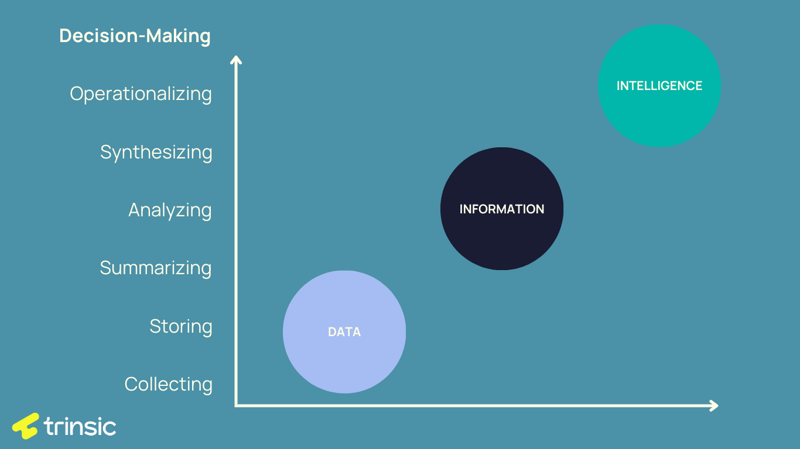November 14, 2023
6 Ways Trinsic's Calculation Engine Empowers Data-Driven Decisions
Written by: Trinsic

What You'll Learn
In this article, we'll explain six unique capabilities powered by our human data platform's Calculation Engine that provide the foundation for real-time operational intelligence and data-informed decision-making:
- Population Statistics
- Metric Reliability Analysis
- Time-Series Analysis
- Clustering & Segmentation
- Anomaly Detection
- Predictive Modeling
Show me the summary
With the advent of increasingly precise and affordable sensors integrated into measurement devices and wearables, coupled with the growing digital documentation of human behaviors, we are experiencing an unprecedented surge in data collection.
While data management systems evolved to fill a gap to centralize data into a single source for aggregation and visualization, we still find ourselves swimming in an ocean of real-world human data that can transform how we approach human health, readiness, and performance.
The technological advancement is undeniably promising, but it also presents a pressing challenge: how do we efficiently and effectively transform this wealth of data into actionable intelligence, ultimately empowering better decision-making?
Navigating the Data Dilemma: Transforming Raw Human Data into Invaluable Insights
While data management tools serve as valuable allies in aggregating and presenting diverse metrics, the true potential of the data lies in the ability to unearth profound insights that might otherwise remain hidden.
Drawing from Years of Technical Expertise
Our understanding of these challenges doesn't stem solely from customer feedback; we've been in the trenches for years.
This is why we've meticulously engineered the Calculation Engine at the core of our human data platform to streamline and optimize converting data into actionable intelligence.
By harnessing existing and continuously collected real-world data from a breadth of sources, this engine supports capabilities unique to human health and performance. The promise of big data insights and continuous learning is embedded into a secure, scalable platform to synthesize your diverse data sources into real-time information to support decision-making.
Discover Six Key Functions of Our Calc Engine
Here, we unveil six distinctive functions that our Calculation Engine offers, designed to empower organizations in harnessing their data to its fullest potential.
Population Statistics
Relevant context and normative results enable practitioners to use data with precision and clarity.
Population statistics, a unique consideration for human data, are a versatile tool that goes beyond mere data presentation. They offer a comprehensive view of context-relevant information, allowing comparisons across various "out-of-the-box" or custom cohorts. These statistics continue to enhance the relevance of the data by incorporating different user demographics, such as occupation, sport, competitive level, military branch, or organization.

This customization not only refines normative results for benchmarking but also aids in interpreting the data's clinical significance within specific subpopulations. As a result, practitioners are equipped to discern actionable insights that drive informed decision-making and personalized care. The population statistics and normative capabilities of the Calculation Engine exemplify some of the critical capabilities unique to analyzing and utilizing real-world human data.
Metric Reliability Analysis
Can you truly, with confidence, say that you trust the accuracy of your data?
Another unique consideration for human-centric data is reliability. By analyzing central tendencies and variability of data, practitioners can distinguish reliable data from unreliable sources. Understanding data reliability is crucial in determining which metrics can be used as the basis for strategic decisions.

This capability can leverage common data elements across our customers or be applied to specific data sources and populations for unique environments. This capability separates meaningful information from statistical noise, understanding what is significant and what isn't. Reliable data ensures that organizations can confidently make decisions based on a solid foundation, enhancing decision-making and promoting better outcomes.
Advanced (AI/ML) Analysis
The Calculation Engine embeds advanced (AI/ML) analytics directly into the platform, completing the loop between collecting, analyzing, and operationalizing data.
Our big data approach goes beyond the limitations of traditional experimental methods. It offers a truly unbiased approach to understanding complex data. Various innovative techniques can be applied to optimize the operationality utility of the data organizations are collecting:
Time-Series Analysis
Say goodbye to bias and hello to the future of data-driven decision-making.
Many sources of human observation data include continuous time-series data that is usually derived into discrete metrics for interpretation or analysis. For example, wearables will continuously collect data one to five times per second (1-5 Hz), and these frequencies may dynamically adjust based on rest-activity rhythm (e.g., sleep, exercise). Motion capture devices such as accelerometers and gyroscopes (IMUs) and force platforms can sample data at rates ranging from 100-1000 Hz (samples per second) or more. This continuous time-series data is generally resolved into discrete metrics before most people access it, such as Average Resting Heart Rate or Max Velocity. However, the raw time-series data itself can also be analyzed!
While these discrete metrics can be helpful, when this granular data is resolved into simpler components, there is always the risk of losing or biasing information. Unsupervised machine learning techniques like neural networks can comb through time-series data to identify hidden features that may summarize this data better than traditional discrete metrics (e.g., mean, median, range).
The benefit? These innovative AI/ML techniques can allow us to uncover more reliable, valid, and useful metrics using a less biased (faster, more scalable, and more flexible) approach than traditional analysis.
Clustering & Segmentation
Unlocking personalized insights and revealing unique patterns to optimize well-being and performance at scale.
Other advanced techniques like clustering can be used to identify hidden patterns and groupings (e.g., phenotypes) across combinations of various data sources. This technique has been used in everyday applications such as Spotify and Google Ads to identify groups of listeners or consumers with similar behavior to provide suggestions. It is also prevalent in healthcare, with examples in pharmacology and concussion sub-typing.
The Calculation Engine enables the segmentation of individuals into unique groups and subgroups within populations based on the complex interaction of multiple human data types and sources.

This segmentation can provide insight into everything from needs analyses to occupational fit, for example:
- Individuals that may have similar/differing needs to improve movement health outcomes
- Individuals with similar/differing performance characteristics
- Individuals with similar/differing fitness behaviors and capabilities
- Individuals that display similar/differing rehabilitation trajectories
Anomaly Detection
Empowering proactive decision-making by uncovering hidden irregularities that can't be ignored.
Similar to credit card fraud detection, AI/ML techniques can help detect critical anomalies or unusual changes in human characteristics or health. Earlier detection enables faster intervention and limits the downstream cost for the cardholder and the company.
You may have heard stories about Apple Watches alerting users of abnormal heart rhythms, recommending them to seek professional opinions, and the harrowing stories of them narrowly escaping tragedy, personally and financially.

These consumer-facing capabilities from wearables are possible at an enterprise scale with our Calculation Engine and your human data sources. This subtle workflow change has the potential to both improve performance and health outcomes and streamline resources in the process.
Predictive Modeling
Custom modeling, driven by domain expertise, facilitates real-time decision-making for the outcomes that matter most.
Organizations looking to optimize specific outcomes can leverage predictive modeling for a range of crucial metrics, from risk assessment to readiness, performance, rehabilitation, and other vital outcomes. Leveraging supervised machine learning models, organizations can segment users based on selected outcome likelihood, such as:
- Risk Classification (MSK injury, failure, or fall risk)
- Diagnostic/Prognostic classification (mTBI treatment paths or rehabilitation status)
- Performance Projection (for example, in-game performance or fitness capabilities)
- Readiness Levels (combining subjective and objective data sources)

Custom population-specific, outcome-specific, and performance-specific models are developed through Data Science services, leveraging customer-specific domain expertise to ensure clinically and operationally relevant outputs. The Calc Engine enables custom models to be deployed directly into the platform so human-based decisions can be operationalized in real-time at the point of care.
Part of a Greater Whole
The Calc Engine is not the main component of our platform, but it is an essential element. We will continue to delve into other components of our platform that connect with and are supported by the Calc Engine in future posts. Our platform is built upon a scalable and secure infrastructure also includes a data catalog, data lakehouse, open integration, and an ecosystem of different connected applications and management consoles.
Outside of technical infrastructure, our Customer Success Team works to support optimal training, education, solutions engineering, and deployment. At the same time, our Data Science team can leverage our platform's capabilities to deliver insights directly to your people, where and when they need it.
Your Data, Your Choice
Whether you rely on our expert data science team or prefer direct access to our platform, we empower your journey to data-driven success.
The Calculation Engine can also be an interactive and collaborative hub for our customers and partners. Beyond leveraging the platform's built-in capabilities, organizations that employ data scientists, machine learning engineers, and data analysts have the flexibility for their experts to interact with the Calculation Engine on a deeper level. They can deploy custom models and algorithms, creating a dynamic environment where innovation and data-driven insights thrive. This collaborative approach empowers our users to harness the full potential of their data and explore unique solutions tailored to their specific needs.
No data science team? No problem; you can leverage our data team to collaborate with your health, performance, and operational experts to optimize the Calc Engine's outputs to meet your needs!
Take Home:
- With over a decade of handling complex real-world human data, we've intentionally engineered our Calc Engine with these unique considerations in mind.
- Transformative AI/ML capabilities can be leveraged to provide insights and assist decision-making to optimize human health and performance.
- The Calc Engine is one component of our larger data platform and expert team, helping organizations leverage human data to optimize their people.
Tag(s):
Technology
,
Human Data Platform
,
AI/ML
,
Big Data
,
Calculation Engine
,
Human Data
,
Trinsic
Other posts you might be interested in:
View All Posts
Technology
7 min read
| October 11, 2023
Evolving Data Warehouses to Data Platforms
Read More
Data
8 min read
| September 13, 2023
Deciphering the Unique Nature and Value of Human Observation Data
Read More
Data
13 min read
| August 1, 2023